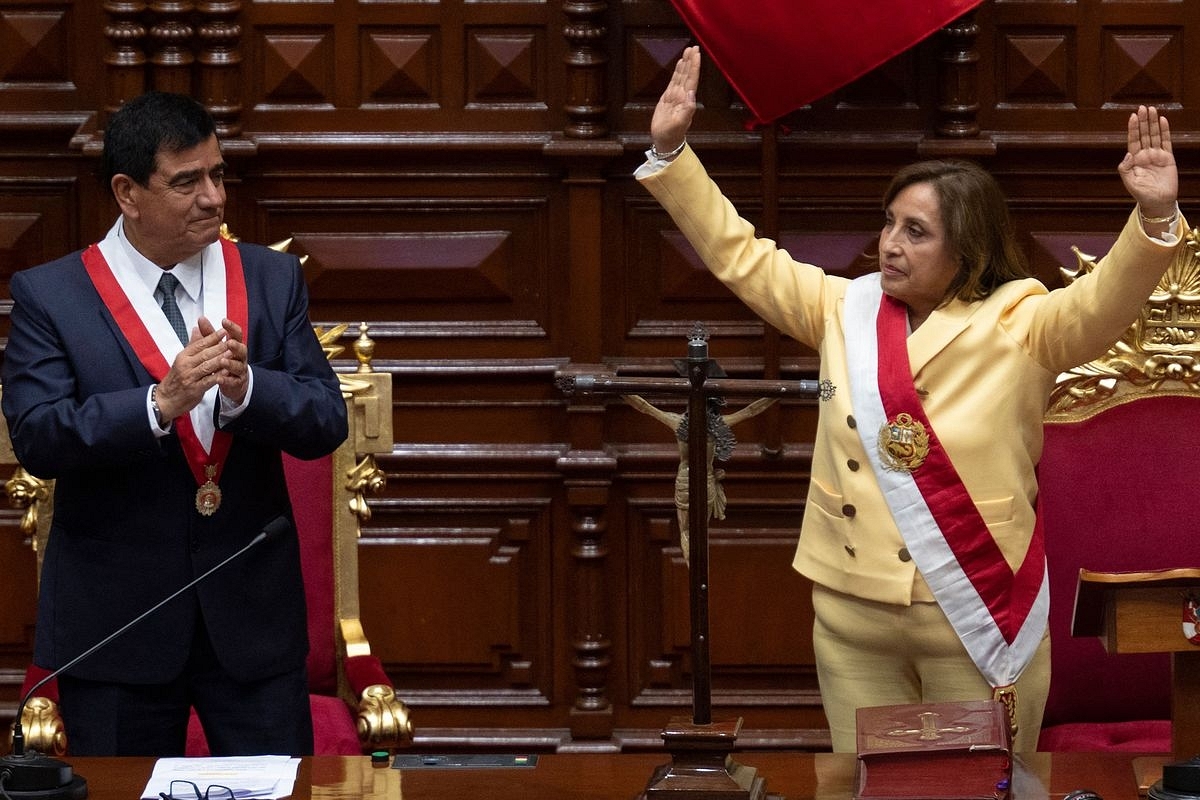World
Explained: The Political Crisis In Peru And The Coup Attempt

Peru's new president
The new President of Peru, Dina Boluarte, has announced the composition of her government on Saturday December 10, as discontent grows in the streets, where supporters of the former President, Pedro Castillo, are demanding his release and new elections. The new government has 19 ministers, including eight women. The former prosecutor who specialized in the fight against corruption has been appointed Prime Minister.
Many demonstrations and roadblocks have been taking place since Thursday in Lima and in several cities of the country, especially in the Andean regions, where Pedro Castillo, a former rural schoolteacher, has the greatest support.
Students, workers and left-wing political parties had called for a demonstration in Lima, Saturday at 9 p.m., after the end of the quarter-finals of the World Cup in Qatar. Mrs. Boluarte, Vice President until her inauguration on Wednesday after the dismissal of Pedro Castillo by Parliament, has not ruled out the organization of early elections.
"If society and the situation warrant it, we will propose elections as part of discussions with the democratic forces of Congress," said Mrs. Boluarte, wishing to seek a peaceful solution to the political crisis and the growing anger on the street.
Hundreds of people marched Friday in the streets of the Peruvian capital to demand the release of Pedro Castillo. Chanting "putschist", the protesters burned banners with the effigy of Dina Boluarte.
The police used tear gas on Thursday to disperse the demonstrators who were already heading towards Parliament, displaying signs "Freedom for Castillo", "Boluarte does not represent me" or "Dissolution of Parliament".
After his failed attempt on Wednesday to dissolve Parliament and impose a state of emergency, a maneuver qualified as a "coup d'etat", Pedro Castillo was placed in provisional detention for seven days on the request of the prosecutor, who is prosecuting him for "rebellion" and "conspiracy".
His former chief of staff, Guido Bellido, and Me Guillermo Olivera, one of his lawyers, suggested on Friday that Pedro Castillo may have been "perhaps incited" to dissolve Parliament under the influence of psychotropics.
While Parliament was to debate a third motion of dismissal against President Castillo for "moral incapacity" since his accession to power in July 2021, the man who was still head of the country made a solemn statement on television, wearing the presidential sash, announcing the dissolution of Parliament and the imposition of a state of emergency in the country.
"He does not remember" his TV announcement, said Mr. Bellido, calling for an "urgent toxicology test" on the former teacher. Peru is notorious for being a politically unstable nation.
Peru has a history of authoritarian governments, particularly during the 20th century, which left a legacy of distrust and mistrust in the political system.
The country gained its independence from Spain in 1821, but it wasn't until the 1960s that it began to see any real stability in its government. The first coup in Peru's history took place in 1948, when General Manuel A. Odría seized power in a bloodless coup. Odría ruled the country with an iron fist for nearly a decade, suppressing political opposition and cracking down on civil liberties.
In 1956, a popular uprising known as the "Revolution of the Park" toppled Odría's government and brought back civilian rule. However, this period of stability was short-lived, as a series of coups and counter-coups rocked the country throughout the 1960s and 1970s.
One of the most significant coups in Peru's history took place in 1968, when General Juan Velasco Alvarado seized power. Velasco implemented a series of sweeping reforms, including nationalizing the country's major industries and redistributing land to the poor. However, his authoritarian style of governance and heavy-handed economic policies ultimately led to his downfall in 1975.
The 1980s saw a return to civilian rule, but the country was plagued by economic instability and hyperinflation. In 1992, a group of military officers led by Alberto Fujimori staged a coup, claiming that the government was unable to address the country's economic crisis.
Fujimori ruled Peru with an iron fist for nearly a decade, suppressing political opposition and using the military to crack down on insurgency groups. However, his rule was marred by widespread corruption and human rights abuses, and he was eventually forced to resign in 2000.
Since Fujimori's resignation, Peru has seen a return to democratic rule, with regular elections.
Peru is also one of the most unequal countries in Latin America, with a high poverty rate and a concentration of wealth among a small elite. This economic inequality has fuelled social and political tensions. It is also diverse nation, which is never a good thing as it erodes social cohesion.
The complex history of regional and ethnic tensions often manifest in political conflict, particularly between the central government and regions with strong indigenous or separatist movements.
Support Swarajya's 50 Ground Reports Project & Sponsor A Story
Every general election Swarajya does a 50 ground reports project.
Aimed only at serious readers and those who appreciate the nuances of political undercurrents, the project provides a sense of India's electoral landscape. As you know, these reports are produced after considerable investment of travel, time and effort on the ground.
This time too we've kicked off the project in style and have covered over 30 constituencies already. If you're someone who appreciates such work and have enjoyed our coverage please consider sponsoring a ground report for just Rs 2999 to Rs 19,999 - it goes a long way in helping us produce more quality reportage.
You can also back this project by becoming a subscriber for as little as Rs 999 - so do click on this links and choose a plan that suits you and back us.
Click below to contribute.
Latest